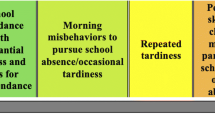ABSTRACT
This paper explores the educational opportunities available to community youth development professionals in the United States. Given the complexity of the needs of today’s young people, it is both timely and prudent to increase the type, quality, and quantity of educational experiences available to community youth development professionals. Researchers, practitioners, policymakers, and funding agencies have all begun to explore the importance of providing educational opportunities to community youth development professionals. The findings of this investigation indicate a need for a comprehensive multidimensional educational system to provide community youth development professionals with the knowledge and skills essential to successfully meet the challenges they encounter in their daily work.

Similar content being viewed by others
References
Borden, L. M., (2002). Educating youth development professionals: Current realities, future potential. Commissioned report by National 4-H Council. Tucson, AZ: University of Arizona, Institute for Children, Youth, and Families. http://www.arizona.edu/pubs
Borden, L., Yohalem, N., Blyth, D., & Morales, J., (2000, Fall). Advancing the understanding of youth development and its effective application: Reflections on the North Central Region’s recent efforts. The Center, (Center for 4-H Youth Development, University of Minnesota), pp. 54–55
Eccles, J. S., & Gootman, J. A. (Eds.). (2002). Community programs to promote youth development. Committee on community-level programs for youth, Board on Children, Youth, and Families, Division of Behavioral and Social Sciences and Education, National Research Council and Institute of Medicine. Washington, DC: National Academy Press
Greenwood E., (1957). Attributes of a profession Social Work 2(3): 44–55
Hahn A., Raley G., (1998). Youth development: On the path toward professionalization Nonprofit Management & Leadership 8(4): 387–401
Krueger, M., (2000, February). How about education, competence—and a pay raise? Youth Today
Lerner R. M., Hertzog S. M., (2003). Creating a community youth development profession: From vision to instantiation Medford, MA Tufts University
McLaughlin M. W., Irby M. A., Langman J., (1994). Urban sanctuaries: Neighborhood organizations in the lives and futures of inner-city youth San Francisco Jossey-Bass Publishers
McLaughlin, M., (2000). Community Counts: How youth organizations matter for youth development. Available from Washington, DC: Public Education Network. http://www.PublicEducation.org
Perkins D. F., Borden L. M., (2003). Key elements of community youth development programs In: F. A. Villarruel, D. F. Perkins, L. M. Borden, J. G. Keith, (Eds) Community youth development: Practice, policy, and research Thousand Oaks, CA Sage (pp. 327–340)
Quinn, J., (1995). Positive effects of participation in youth organizations. In M. Rutter (Ed.), Psychological disturbances in young people: Challenges for prevention (pp. 274–304). New York: Cambridge University Press
Wallace-Reader’s Digest Fund. (1996). Progress and opportunities: Strengthening the youth work profession. New York
Zeldin S., (1993). Professional development for youth workers: What is best practice? Washington, DC Academy for Educational Development, Center for Youth Development
Author information
Authors and Affiliations
Corresponding author
Additional information
Support for the work on this article has come from multiple sources. The authors wish to thank the National 4-H Council, United States, for their funding of this research. In addition, the authors wish to acknowledge of the support they received from the Agricultural Experiment Stations and Extension Services related to children, youth, and families of the University of Arizona and The Pennsylvania State University.
Rights and permissions
About this article
Cite this article
Borden, L.M., Perkins, D.F. Community Youth Development Professionals: Providing the Necessary Supports in the United States. Child Youth Care Forum 35, 101–158 (2006). https://doi.org/10.1007/s10566-005-9005-4
Published:
Issue Date:
DOI: https://doi.org/10.1007/s10566-005-9005-4




